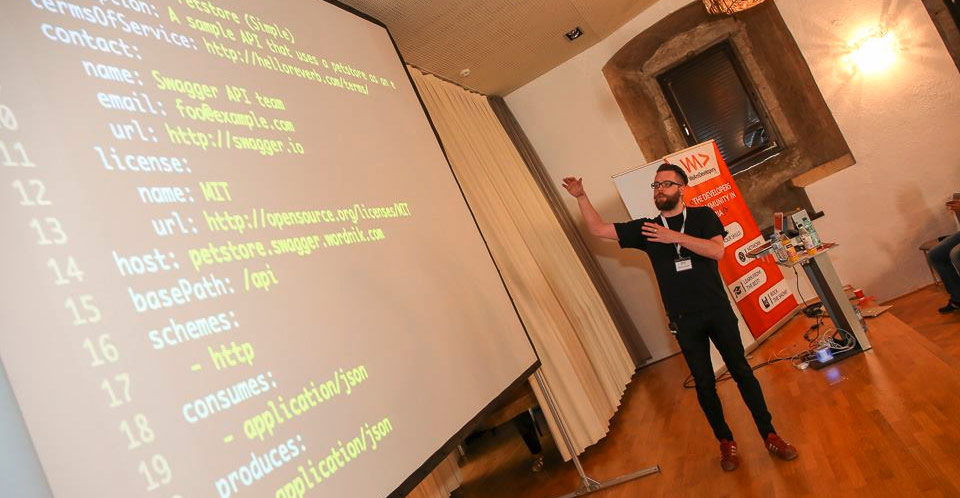
17 Jun Development Process, Team and Technology as Success Factors – WeAreDevelopers (Part 2)
In the second article of this series we continue to sum up the most interesting talks of the WeAreDevelopers conference that took place on 11th June 2015 at Burg Perchtoldsdorf near Vienna. Part one can be found here.
App Development Process
Markus Hinterleitner of REWE Group International (Billa, Merkur, Bipa) gave an insight of how their software/app development process works. They follow the MVP (Minimum Viable Product) strategy by releasing a first version very fast, then listening to the customer and develop apps with an interactive agile process. Their IT and applications strategy is based on the following five pillars: 1. API-first 2. RESTful SOA 3. Horizontal scaling 4. JSON data exchange 5. Distributed data caching.
Karriere.at was represented by Michael Feichtinger, who talked about engineering culture within a development team and the secret ingredients for great software: communication, process, feature-quality-support, and people. When it comes to communication, more is always better and you should always tell the backstory to give more , repeat and visualize. Then there is the process, where he claims that „less is always better“. This means that teams should define their custom-made processes on which everybody must agree and which should improved after try and error. As far as quality is concerned there must alway be one person in charge. The deployment process is important as well and everybody in the team must do quality! The probably most important factor is the people. In his opinion, the perfect developer hast drive, flexibility, humbleness and pain-tolerance. His advice is to recruit only people that fit into the team and to keep diversity in mind. It’s a people business and everyone is different, people love freedom. To sum it all up: Hire good PEOPLE, build a simple PROCESS.
Product Development and APIs
How to create software that people want? That was the topic of the talk of Thomas Schranz, CEO & co-founder of Blossom.io. He started with the quote „Don’t make customers happy. Make happy customers.“ When designing a product you should always think about a specific person. Your aim should be to „give the customer super powers“ and understand the problems of the customer better than the customer himself. For example, Instagram’s goal was to make the user a better photographer. A simple UI and few options means less things to decide for the user. Positioning if the product is a very important factor as well. Think about the „W“ questions: Who are you? What do you want? What is your desire? Why are you here? Where are you going? The speaker also claimed that the first few seconds after starting the app for the first time are really the most important ones. There is a concept of „jobs to be done“, which means that the situation is more important than the persona itself. Don’t think about the product features, dont’s think about the persona or single user, think about the actual situation in which a user is!
Markus Kossatz from Hitbox gave his talk about how to develop innovative scalable systems with Node.js, Redis and AWS. Web development and Javascript was also a topic in the next talk by Ali Sharif from 25th-floor. His company is using ngReact, an Angular module that allows React Components to be used in AngularJS applications.
Michael Schärfer from diamond:dogs talked about how to design an awesome API. He provide four key learnings: 1. There can be an internal and a consumer facing API. 2. The API can be seen as a product as well. 3. It should be easy to learn and hard to mis-use. 4. It should be appropriate to the audience and appropriate to the problem. Swagger has become the best known tool for designing and developing an API incl. code generation. But there are also anti-patterns for how to not design an API: 1. Mixed up conventions – pick one and be consistent. 2. Parameter confusion. 3. Sequential identifiers – this is bad for security reasons. 4. Insecure direct object reference. The speaker conjured the developers in the audience to validate everything and return meaningful error codes, not just the generic code 500. In addition versioning of the RESTful API can be used. For mobile app development the content should be gzipped, cache headers should be used and there should be a convenient access to resources.
Team
The last keynote of the day was given by Armin Strbac, CEO and co-founder of Shpock, about diverse teams as a success factor for startups. Shpock is a mobile app for Android and iOS, and by their own definition the #1 next-gen marketplace app. The company from Vienna, Austria employs 40 team members from 13 different nations. Basically for Strbac it all comes down to „Team, Team, Team“. Aim for focus, speed and know-how and keep in mind that „greatness and comfort rarely coexist“. His last pointer for other startups was to „stay relevant or disappear“.
We at creative workline GmbH would love to hear your feedback! Were you at the event too? Do you face the same challenges in your team or startup, do you use the same technologies? We’ll definitely take away a lot of new insights and will try to improve our software development processes, mobile app products and services every day a bit more.



Technology Trends of Tomorrow - IoT & LBS - WeAreDevelopers (Part 1) - App Entwicklung in Wien - creative workline GmbH
Veröffentlicht um 15:22h, 17 Juni[…] Update: Part two of this article can be found here. […]